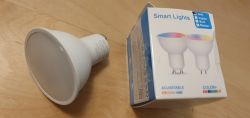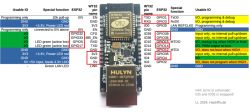Hello, I just got this device and it works perfectly with the Smart life application. Unfortunately, the HA tuya integration does not support the IR devices.
I have disassembled the device and checked if it is tasmota compatible, but I've found that it's a BK7231T based device. Googling, I have found this forum and I want to share my experience.
![[BK7231T] Tuya Smart IR NAS-IR02W6 v3: Flashing & Compatibility Issues with Home Assistant [BK7231T] Tuya Smart IR NAS-IR02W6 v3: Flashing & Compatibility Issues with Home Assistant](https://obrazki.elektroda.pl/2129193900_1670533906_thumb.jpg)
I have tried to read/flash the device with a USB to TTL adapter and with an Arduino as a TTL converter. For both cases, the Windows tool simply does not detect anything. I have tested the two points labeled as RX and TX. Then I load the firmware and click program, the short CEN to GND to reset. The device seems to reset, but nothing is detected. By the LEDs in the USB to TTL adaptor, it looks like it's not getting any data from the BK7231T.
I have spent some hours on it and I was not able to make it work; I don't see what else could I try.
Does somebody was able to flash this device? Or have any advice? I have run out of ideas
I have disassembled the device and checked if it is tasmota compatible, but I've found that it's a BK7231T based device. Googling, I have found this forum and I want to share my experience.
![[BK7231T] Tuya Smart IR NAS-IR02W6 v3: Flashing & Compatibility Issues with Home Assistant [BK7231T] Tuya Smart IR NAS-IR02W6 v3: Flashing & Compatibility Issues with Home Assistant](https://obrazki.elektroda.pl/2129193900_1670533906_thumb.jpg)
I have tried to read/flash the device with a USB to TTL adapter and with an Arduino as a TTL converter. For both cases, the Windows tool simply does not detect anything. I have tested the two points labeled as RX and TX. Then I load the firmware and click program, the short CEN to GND to reset. The device seems to reset, but nothing is detected. By the LEDs in the USB to TTL adaptor, it looks like it's not getting any data from the BK7231T.
I have spent some hours on it and I was not able to make it work; I don't see what else could I try.
Does somebody was able to flash this device? Or have any advice? I have run out of ideas







![[BK7231T] Tuya Smart IR NAS-IR02W6 v3: Flashing & Compatibility Issues with Home Assistant [BK7231T] Tuya Smart IR NAS-IR02W6 v3: Flashing & Compatibility Issues with Home Assistant](https://obrazki.elektroda.pl/2523539000_1670748277_thumb.jpg)
![[BK7231T] Tuya Smart IR NAS-IR02W6 v3: Flashing & Compatibility Issues with Home Assistant [BK7231T] Tuya Smart IR NAS-IR02W6 v3: Flashing & Compatibility Issues with Home Assistant](https://obrazki.elektroda.pl/7737587000_1672600513_thumb.jpg)
![[BK7231T] Tuya Smart IR NAS-IR02W6 v3: Flashing & Compatibility Issues with Home Assistant [BK7231T] Tuya Smart IR NAS-IR02W6 v3: Flashing & Compatibility Issues with Home Assistant](https://obrazki.elektroda.pl/3351123600_1672600542_thumb.jpg)
![[BK7231T] Tuya Smart IR NAS-IR02W6 v3: Flashing & Compatibility Issues with Home Assistant [BK7231T] Tuya Smart IR NAS-IR02W6 v3: Flashing & Compatibility Issues with Home Assistant](https://obrazki.elektroda.pl/9435666300_1680408988_thumb.jpg)